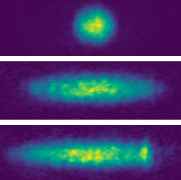‘Negative mass’ created at Washington State University
April 21, 2017

Experimental images of an expanding spin-orbit superfluid Bose-Einstein condensate at different expansion times (credit: M. A. Khamehchi et al./Physical Review Letters)
Washington State University (WSU) physicists have created a fluid with “negative mass,” which means that if you push it, it accelerates toward you instead of away, in apparent violation of Newton’s laws.
The phenomenon can be used to explore some of the more challenging concepts of the cosmos, said Michael Forbes, PhD, a WSU assistant professor of physics and astronomy and an affiliate assistant professor at the University of Washington. The research appeared Monday (April 17, 2017) in the journal Physical Review Letters.
How to create negative mass
The researchers created the conditions for negative mass by cooling about 10,000 rubidium atoms to just above absolute zero, creating a Bose-Einstein condensate (in which individual atoms move as one object). In this state, particles move extremely slowly and, following the principles of quantum mechanics, behave like waves. They also synchronize and move in unison as a “superfluid” that flows without losing energy.
The lasers trapped the atoms as if they were in a bowl measuring less than a hundred micrometers across. At this point, the rubidium superfluid has regular mass. Breaking the bowl will allow the rubidium to rush out, expanding as the rubidium in the center pushes outward.
To create negative mass, the researchers applied a second set of lasers that kicked the atoms back and forth and changed the way they spin. Now when the rubidium rushes out fast enough, if behaves as if it has negative mass.
The technique used by the WSU researchers avoids some of the underlying defects encountered in previous attempts to create negative mass. It could hold clues to the behavior occurring in the heart of ultracold neutron stars, which also act as superfluids, and cosmological phenomena like black holes and dark energy, said Forbes.
The work was supported in part by a WSU New Faculty Seed Grant and the National Science Foundation.
Abstract of Negative-Mass Hydrodynamics in a Spin-Orbit–Coupled Bose-Einstein Condensate
A negative effective mass can be realized in quantum systems by engineering the dispersion relation. A powerful method is provided by spin-orbit coupling, which is currently at the center of intense research efforts. Here we measure an expanding spin-orbit coupled Bose-Einstein condensate whose dispersion features a region of negative effective mass. We observe a range of dynamical phenomena, including the breaking of parity and of Galilean covariance, dynamical instabilities, and self-trapping. The experimental findings are reproduced by a single-band Gross-Pitaevskii simulation, demonstrating that the emerging features—shock waves, soliton trains, self-trapping, etc.—originate from a modified dispersion. Our work also sheds new light on related phenomena in optical lattices, where the underlying periodic structure often complicates their interpretation.